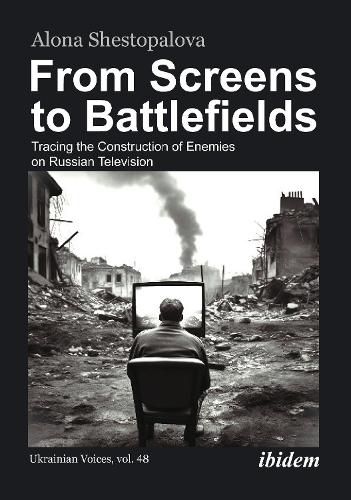Readings Newsletter
Become a Readings Member to make your shopping experience even easier.
Sign in or sign up for free!
You’re not far away from qualifying for FREE standard shipping within Australia
You’ve qualified for FREE standard shipping within Australia
The cart is loading…






This book provides a systematic overview of hostile rhetoric on state-controlled Russian TV and shows how it laid the foundation for the Russian public's widespread acceptance of the full-scale invasion of Ukraine on 24 February 2022. It reveals the strategies behind the Kremlin-directed television coverage of the Euromaidan, Russia's occupation of Crimea, and the first five months of the war in the Donetsk and Luhansk regions of Ukraine and demonstrates that, already in 2013-14, the hostile portrayal, dehumanization, and demonization of Ukraine was omnipresent on Russian TV.
After a nuanced discussion of the concept of the enemy, the author compares the construction of enemies by the Russian state's major international and internal broadcasters - RT (Russia Today) and Channel One. The findings show that both channels purposefully elicited fear and hatred towards Ukraine and Western countries in their audiences. Notably, Channel One-lesser known within the Western pundits community-was more extreme and radical in its coverage than the globally known RT channel. To provide a broader context, Shestopalova also draws parallels between Russian state-controlled communication on Ukraine and Russia's wars of the two previous decades, namely those in Chechnya and Georgia.
$9.00 standard shipping within Australia
FREE standard shipping within Australia for orders over $100.00
Express & International shipping calculated at checkout
This book provides a systematic overview of hostile rhetoric on state-controlled Russian TV and shows how it laid the foundation for the Russian public's widespread acceptance of the full-scale invasion of Ukraine on 24 February 2022. It reveals the strategies behind the Kremlin-directed television coverage of the Euromaidan, Russia's occupation of Crimea, and the first five months of the war in the Donetsk and Luhansk regions of Ukraine and demonstrates that, already in 2013-14, the hostile portrayal, dehumanization, and demonization of Ukraine was omnipresent on Russian TV.
After a nuanced discussion of the concept of the enemy, the author compares the construction of enemies by the Russian state's major international and internal broadcasters - RT (Russia Today) and Channel One. The findings show that both channels purposefully elicited fear and hatred towards Ukraine and Western countries in their audiences. Notably, Channel One-lesser known within the Western pundits community-was more extreme and radical in its coverage than the globally known RT channel. To provide a broader context, Shestopalova also draws parallels between Russian state-controlled communication on Ukraine and Russia's wars of the two previous decades, namely those in Chechnya and Georgia.